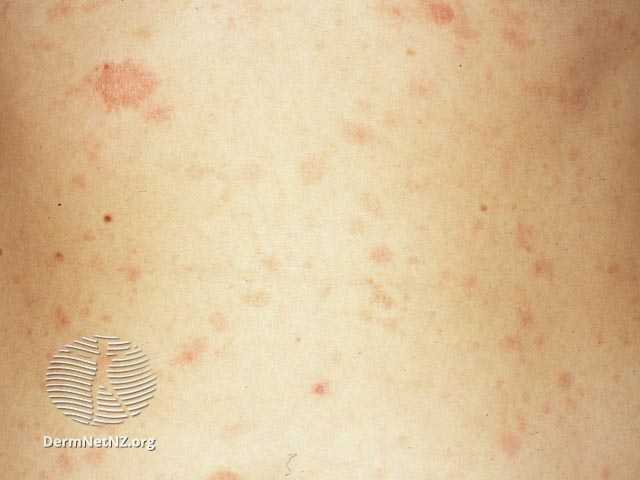Pityriasis Rosea
What is Pityriasis Rosea?
- Pityriasis rosea is a common skin infection that is not contagious and usually resolves on its own within several weeks to months without any specific treatment.
- Aurora Dermatology is now delighted to offer patients Narrowband UVB therapy for pityriasis – with session bulk-billed after initial consult. Find out more about bulk-billed phototherapy here.

What are the symptoms of Pityriasis Rosea?
- Pityriasis rosea typically starts as a single scaly, large patch on the abdomen, back or chest – this is called a “Herald Spot.” It may be slightly raised, oval, salmon-pink or red and about 2-5cm.
- This initial patch is then followed by smaller patches or spots that spread usually in a distinctive “Christmas Tree” formation.
- This secondary rash is typically pinkish or red.
- The rash is not generally itchy or painful, however there may be some mild to severe itching in about one quarter of all patients.
- A few days before the secondary rash develops, many patients will have flu-like symptoms such as a sore throat or a cough.
- The secondary rash plaques tend to be smaller than the initial Herald Patch and are often oval in shape. Sometimes there is a worsening or second wave of the rash before it spontaneously resolves.
- The image below, courtesy of DermNet NZ shows Pityriasis Rosea with a Herald Spot on the trunk.image

What causes Pityriasis Rosea?
- The cause is unknown, but it’s thought to be linked to a type of herpes virus, or influenza virus.
- Other culprits may include vaccines (Covid-19, Bacillus Calmette-Guerin, H1NS, diphtheria, smallpox, hepatitis B, Pneumococcus).
- Drug reactions may also cause pityriasis rosea, including but not limited to: nonsteroidal anti-inflammatory drugs (for pain), D-Penicillamine (for lead poisoning), isotretinoin (for acne), barbiturates (sedative) clozapine (antipsychotic), clonidine and hydrochlorothiazide, (anti-hypertensives) and some cancer drugs.
Who gets Pityriasis Rosea?
- Pityriasis rosea can affect all ages, but tends to occur more in women and is also common in teenagers and young adults.
Most cases occur in winter.
Are there any long-term side effects of Pityriasis Rosea?
- Most side effects of pityriasis rosea are self-limiting.
- Although the side effects of pityriasis rosea are generally mild it is important to see your dermatologist if symptoms persist to rule out tinea corporis or ringworm which can look like pityriasis. Eczema (atopic dermatitis), nummular eczema (a round coin-shaped eczema), psoriasis and drug eruptions can also be frequently misdiagnosed by doctors as pityriasis.
- Less commonly there have been reports of premature delivery and foetal demise during pregnancy, within the first 15 weeks of gestation – due to pityriasis.
- Rarely pityriasis can be linked to a severe cutaneous adverse reaction (drug hypersensitivity syndrome).
- Prolonged skin discolouration is also a possible long-term issue.
What is the treatment for Pityriasis Rosea?
- Treatment typically focuses on symptom relief and the condition tends to resolve on its own in a few weeks or months.
- Moisturisers can help relieve mild itch, as can topical corticosteroids.
- In severe cases, oral antihistamines may be prescribed.
- Extensive or persistent cases of pityriasis can be treated by Narrowband UVB therapy, which we now offer at Aurora Dermatology. It is also used to treat psoriasis, eczema and vitiligo.
- Find out more about bulk-billed phototherapy here.

